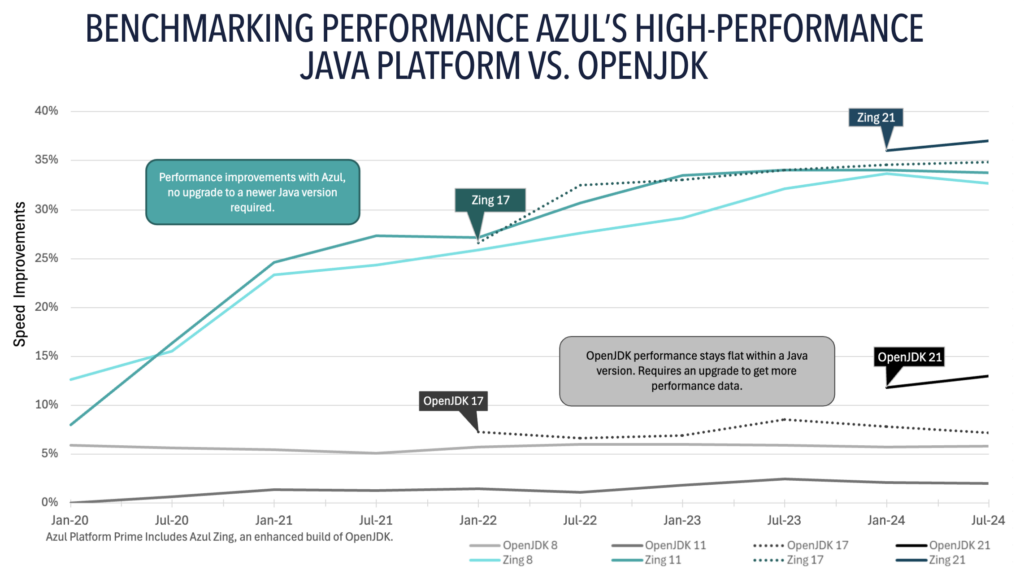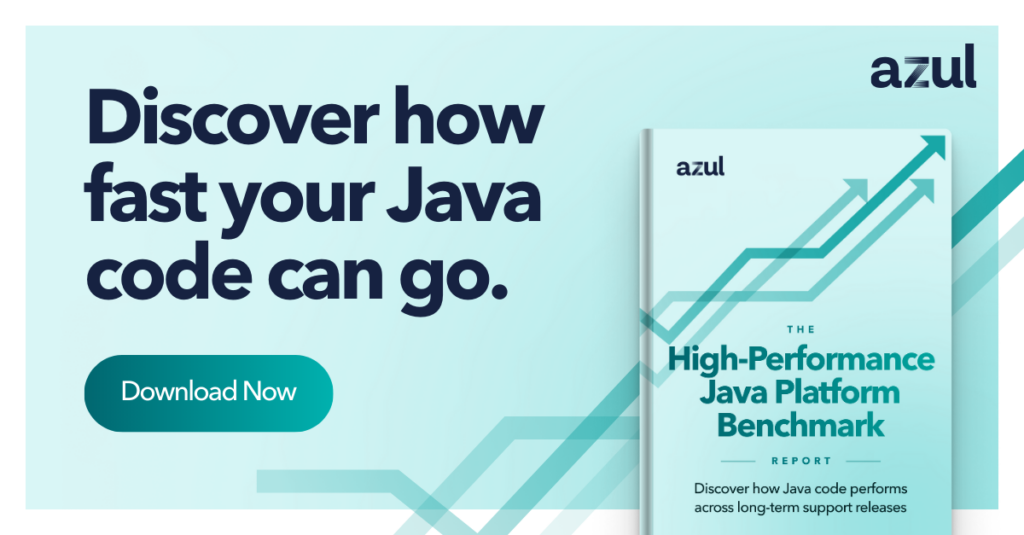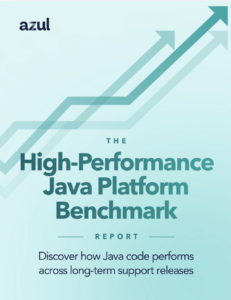
In a new benchmark study, Azul compares Azul Platform Prime to a traditional build of OpenJDK to assess how fast Java code can perform across Java long-term support (LTS) releases. The report also shows how Azul accelerates Java performance improvement for each Java version before the next Long-Term Support release.
Companies demand the highest levels of application performance and responsiveness without the need to over-allocate cloud resources. The new High-Performance Java Platform Benchmark Report from Azul evaluates common TCK-verified Java distributions in terms of code speed – specifically OpenJDK and Azul Platform Prime. Platform Prime includes Azul Zing, an award-winning JDK that improves application performance, responsiveness, and DevOps efficiency while cutting your cloud bill.
The benchmark found that each new version of Azul Platform Prime delivers superior speed and performance versus the baseline from launch, while new releases of OpenJDK deliver speed that is essentially the same as the baseline.
Each version of Prime improves until the next version, while OpenJDK only improves when each new version comes out.
Up to 37% performance improvement for revenue-generating applications
How does it work and what do we measure?
Azul runs benchmarks every quarter against OpenJDK for startup time, warmup time, peak performance, and reliability. Azul Platform Prime outperforms traditional OpenJDK by up to 37% with faster warmup and fewer pauses.
Let’s look at the speed of Prime versus OpenJDK by recent benchmarks for Java 17 and 21.

JDK17, January 2022
Out of the gate, we found that OpenJDK 17 was 6% faster compared to our baseline, while Azul Platform Prime was 26% faster compared to our baseline.
JDK 21, January 2024
OpenJDK 21 was 12% faster than the benchmark at open, while Prime was 37% faster than the benchmark.
Azul achieves these results through its Java Performance Engineering Lab, which collaborates with global Java developers and customers’ technical teams to deliver enhanced Java performance under a strict SLA. The lab measures code optimizations and provides in-depth analysis of performance impacts from new OpenJDK releases.
Why does a high-performance Java platform matter?
Downtime no longer works as a measure of application reliability. Even a slight degradation in performance fails to meet the lofty expectations of today’s enterprises and their customers.
With certain high-performance Java platforms, you can get cost relief on existing lift-and-shift applications without changing a line of code or upgrading them to a different Java version.
Zing is ideal for Java applications under performance SLAs, common technical benefits include:
- Lower CPU consumption at higher loads
- Reduced instances needed
- Higher carrying capacity and improved throughput
- Lower latency and better response times
- Improved customer experience
- Handling more work with the same resources
- Reduced manual performance tuning for a faster time to market
This is especially true of Azul Platform Prime, which is based on OpenJDK and delivers faster code, faster warmup, and pauseless garbage collection to all LTS versions of Java. GraalVM EE also delivers faster code, although it doesn’t have pauseless garbage collection and you most likely can’t use Graal Native Image to optimize warmup without making code changes.
Whether you have applications that have been rearchitected to be cloud-native, a high-performance Java platform can help you maximize efficiency and minimize costs. High-performance Java platforms help in every major area of cloud Java applications:
- Right-sizing. By improving applications under load, allowing you to utilize more CPU on your instances.
- Elastic scaling. By reducing operational issues with starting new JDKs so you can more fully embrace autoscaling.
- Cloud-native architecture. By raising the number of operations a single server can process, allowing you to reduce the number of horizontally scaled instances needed to meet your traffic.
Of the high-performance Java platforms on the market, only Azul Zing Builds of OpenJDK delivers benefits in all three of these areas, on all major Java versions, without having to change any of your code. See how some of Azul’s customers have used Zing to optimize their cloud cost.
Conclusion
With the help of Azul’s Java Performance Engineering Lab, Azul demonstrates superior performance in several ways:
- What you run in production today will run 20% or more faster – without the need to change or recompile your code.
- No matter which Java version you run, you will get immediate performance gains running any LTS since Java 8 without having to upgrade to a new Java version. We continue to work with the Java community to benchmark and increase Zing’s performance to improve how fast your code can go.
- OpenJDK takes a long time to achieve even modest improvements. The velocity of performance improvements in Zing is far superior.
In addition, Azul’s high-performance Java platform uses fewer resources to achieve the same or even greater performance. This efficiency enables organizations to save on infrastructure costs, especially expensive cloud instances. A high-performance Java platform is one tool in your toolbox for lowering cloud costs. Learn more in The High-Performance Java Platform Benchmark Report, available to read for free from Azul.






